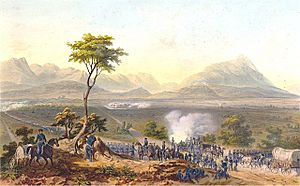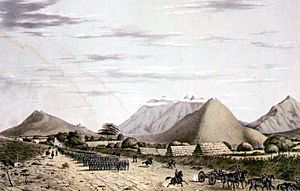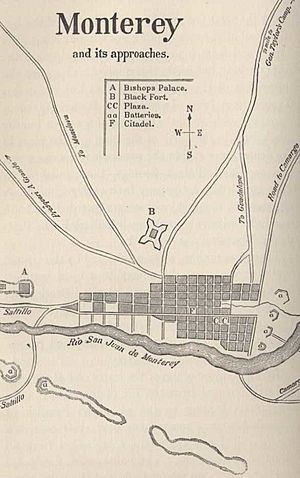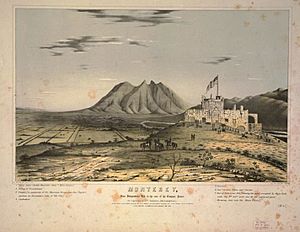Battle of Monterrey facts for kids
Quick facts for kids Battle of Monterrey |
|||||||
|---|---|---|---|---|---|---|---|
| Part of Mexican–American War | |||||||
 US troops marching on Monterrey during the Mexican–American War, lithograph by Carl Nebel |
|||||||
|
|||||||
| Belligerents | |||||||
| Commanders and leaders | |||||||
| Zachary Taylor | Pedro de Ampudia Jose Garcia-Conde Francisco Mejia |
||||||
| Strength | |||||||
| 6,220 | 7,303 | ||||||
| Casualties and losses | |||||||
| 120 killed 368 wounded 43 missing |
367 killed & wounded | ||||||
The Battle of Monterrey was an important fight during the Mexican–American War. It took place from September 21 to 24, 1846, in the city of Monterrey, Mexico. In this battle, the Mexican Army of the North, led by General Pedro de Ampudia, was defeated. They fought against the United States Army of Occupation, which was commanded by General Zachary Taylor.
This battle involved tough fighting inside the city, which led to many soldiers being hurt or killed on both sides. The battle ended when both armies agreed to a two-month break in fighting. The Mexican forces were allowed to leave the city in an orderly way, and the city was given to the American forces.
Contents
Why the Battle of Monterrey Happened
After an earlier battle, General Taylor and his American troops crossed the Rio Grande river. They were ordered by the United States Secretary of War to continue fighting in northern Mexico. Their goal was to capture Monterrey and make the Mexican army want to end the war.
Taylor's army, called the Army of Occupation, gathered about 6,640 men. They began their march towards Monterrey in early September 1846.
Meanwhile, the Mexican forces in Monterrey grew to about 7,300 soldiers. General Pedro de Ampudia was in charge of these troops. He had been told by Antonio López de Santa Anna, a powerful Mexican leader, to move his army further back to the city of Saltillo. However, Ampudia decided to stay and defend Monterrey. He hoped to stop Taylor's advance and gain glory for himself.
Among Ampudia's soldiers were a group of Irish-American volunteers called the San Patricios (or the Saint Patrick's Battalion). This was their first major battle against the U.S. forces.
Key Moments of the Battle
On September 19, Taylor's army arrived near Monterrey. Mexican guns fired at them from a strong point called the citadel. Taylor ordered his army to set up camp while his engineers studied the city's defenses.
The Mexican army had many strong points around the city. These included the "Black Fort," "the Tannery" (La Teneria), and other forts like El Fortín del Rincón del Diablo. To the west of the city, there were forts on hills called Independencia and Federacion, including the Obispado (bishop's palace).
General Taylor decided to attack Monterrey from two sides. General William J. Worth's division would attack from the west. Taylor's main army would attack from the east.
On September 20, Worth's troops began their "hook" movement to the west. They camped for the night a few miles from the main road leading to Saltillo.
Fighting Begins: September 21
On September 21, Worth's troops continued their advance. They fought off a Mexican cavalry charge and managed to cut off the Saltillo road from Monterrey. This was a big step, as it stopped supplies and reinforcements from reaching the city from that direction. Worth's soldiers then quickly captured Fort Soldado and other positions on Federacion hill.
At the same time, Taylor launched his attack from the east. What started as a small attack quickly turned into a full assault. American soldiers captured the tannery and then Fort de La Teneria.
A Quiet Day: September 22
There were no major attacks or fighting on September 22. Both sides likely used this day to rest and prepare for more fighting.
Pushing into the City: September 23
Early on September 23, Worth's troops attacked Fort Libertad on Independencia hill and captured it by morning. With the help of their cannons, they soon took the Obispado as well. This gave them control of the western part of Monterrey.
By this time, the Mexican soldiers had left their outer defenses on the east side of the city. They gathered in the main square, Plaza Mayor. American troops then held the eastern part of Monterrey.
During the intense fighting, a young Mexican woman named María Josefa Zozaya bravely walked into the battle. She was trying to help wounded soldiers from both armies. Sadly, she was hit by a bullet while caring for a U.S. soldier and was likely killed.
By the afternoon, General Worth's troops were moving into the city from the west. They used a new fighting style, moving from house to house. This was a different way of fighting than they had used before, and it helped them avoid heavy losses. Texan volunteers taught the U.S. soldiers how to fight in the city. They learned to clear out Mexican soldiers hiding on rooftops and inside the thick, adobe-walled houses.
Taylor's troops also moved into the city from the east. By the end of the day, both American forces were very close to the main square.
Negotiations and Surrender: September 24
On September 24, General Ampudia decided to talk about a surrender. Taylor and Ampudia agreed to a two-month break in fighting. In return, the city of Monterrey was surrendered to the American forces. The Mexican army was allowed to march out of the city with their personal weapons and some cannons. They left the city between September 26 and 28.
What Happened After the Battle
The agreement between Taylor and Ampudia had a big impact on the war. President James K. Polk of the United States was very upset with Taylor. Polk believed that the U.S. Army should not negotiate truces, but only defeat the enemy. He also thought Taylor's terms, which allowed the Mexican forces to leave with their weapons, were a mistake.
For Mexico, some people believed that the battle marked the beginning of their defeat. Many Mexican soldiers became tired of the war. Their army had fought for three days in a strong, well-supplied city. But they were forced to surrender because of the American army's new city fighting tactics and powerful cannons.
The American army stayed in Monterrey until June 18, 1848. During this time, there were reports of violence against civilians. For example, in January 1847, the Houston Telegraph and Register reported attacks by Texas volunteers. They blamed Mexican civilians for the deaths of some of their friends. Similar attacks happened in other nearby towns like Marín and Apodaca. Most of these attacks were carried out by the Texas Rangers. Some American volunteers spoke out against these attacks, saying the Texas Rangers were committing hate crimes against civilians.
Because of the occupation, many civilians left Monterrey. In response to the American presence, local groups of fighters, called guerrillas, formed. They were led by people like Antonio Canales Rosillo and José Urrea.
See also
 In Spanish: Batalla de Monterrey (Nuevo León) para niños
In Spanish: Batalla de Monterrey (Nuevo León) para niños





